In-Depth with Mac OS X Lion Server
by Andrew Cunningham on August 2, 2011 8:00 AM ESTAddress Book
Now that we’ve spent what seems like an eternity on the ins and outs of OS X Server’s directory and management capabilities, the rest of the review will go by pretty quickly - most of the services are pretty simple to setup and don’t have a lot of moving parts.
The Address Book service, for example, is basically a giant on/off switch with an option to include your directory users’ information in the address book search.
To connect your client computer to the Address Book, go to Mail, Contacts & Calendars in System Preferences, click Other, and then elect to Add a Mac OS X Server account. Either select your server or type in its address, authenticate, and you’ll be asked which services you want to use (based on what services your server offers, and which ones you have permissions to use). If you’ve configured everything correctly, OS X will handle the rest.
You now have a shared, centralized address book for every computer on your network that requests it.
iCal
As with Address Book, the iCal service can begin to be used after the flip of a switch in Server.app, but this time around there are a couple other configurable options.
Mostly, these come in the form of “locations” (like particular buildings or rooms) and “resources” (like computers or projectors) - adding these to your server will make them available as separate calendars, allowing people to schedule time to use them. Designating users or user groups as “delegates” for each location or resource allows the user or users to approve (or disapprove) scheduled meetings.
Otherwise, it’s a pretty standard server for a pretty standard calendaring service: every user on your server gets his or her own calendar, and they can all share them with each other to see what they’re doing. No surprises here.
Connecting OS X clients to iCal servers is accomplished in the Mail, Contacts & Calendars section of System Preferences, just like Address Book. There’s also a simple web interface for the service that becomes available when you turn it on.
iCal web interface
iChat
The iChat service is another on/off switch service, for the most part - your only configurable options are to log chats to the server, and allow users on your server to communicate via iChat with users on another OS X Server (which Apple calls “server-to-server federation” - it’s enabled by default, though you can restrict it if you want).
Connecting to your iChat server is, like iCal and Address Book, accomplished via Mail, Contacts & Calendars in System Preferences.
The next two are a bit more universally applicable - one is to set a quota on your users’ mailboxes, and the next is to enable a Webmail interface for your service - this is accessible by default by typing [your server’s name]/webmail into your address bar, and brings up a webmail interface that is quite usable, though it’s nothing special.
You can also access your Mail service through Mail.app using the Mail, Contacts & Calendars preference pane (the last service for which this is true), or any ol’ POP or IMAP-enabled email client (since POP, IMAP, and SMTP are all supported protocols).
Your last option in Server.app relates to virus and junk mail filtering - there’s a checkbox for the former and a slider for the latter - and blacklisting of known malicious email servers.
If you go into Server Admin you’ll get much more advanced options for configuring and monitoring your mail server. You can view logs and setup email alerts, configure more advanced filtering options, control quotas and maximum message size, enable mailing lists, and control authentication options.
Mail Server is reasonably full-featured, but there’s no getting around the fact that there are better solutions out there - big, established organizations considering adding Mac servers to their fleet are already going to be using competing systems like Exchange (and Microsoft is going to offer support for Exchange that far surpasses whatever Apple provides for OS X Server, from the point of view of most enterprises).
On the other hand, smaller organizations with fewer resources are likely going to be better off going with Google Apps for Business or another equivalent, something that offers the Mail service’s functionality while outsourcing the backend headaches to someone else. However, if you’re a small organization that insists on maintaining full control over all its data and aren’t willing to outsource, the Mail service could be useful to you.


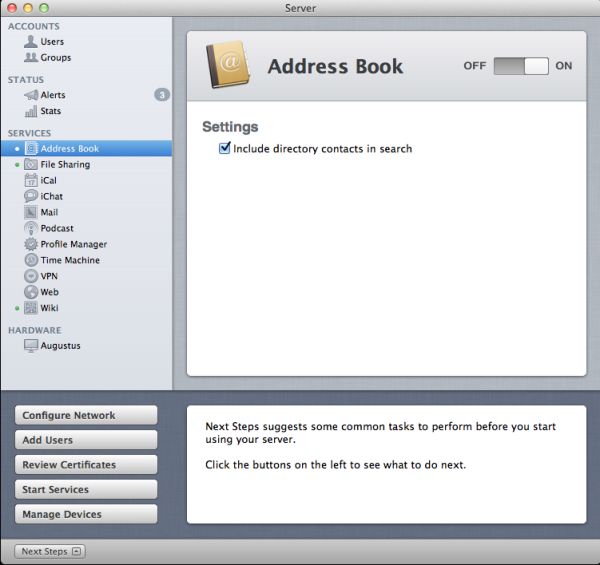
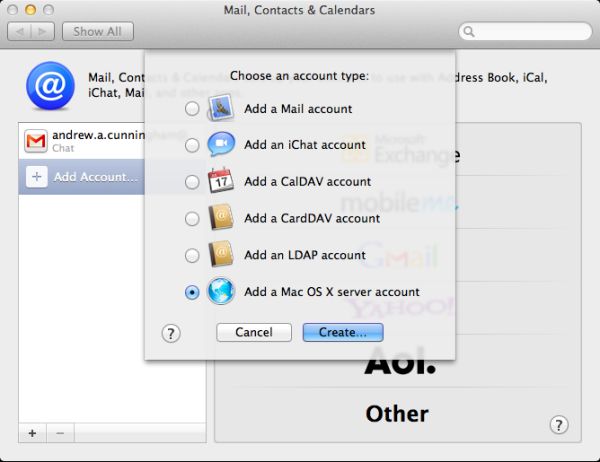
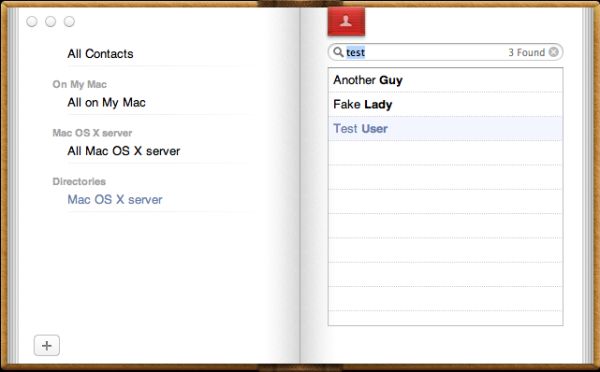
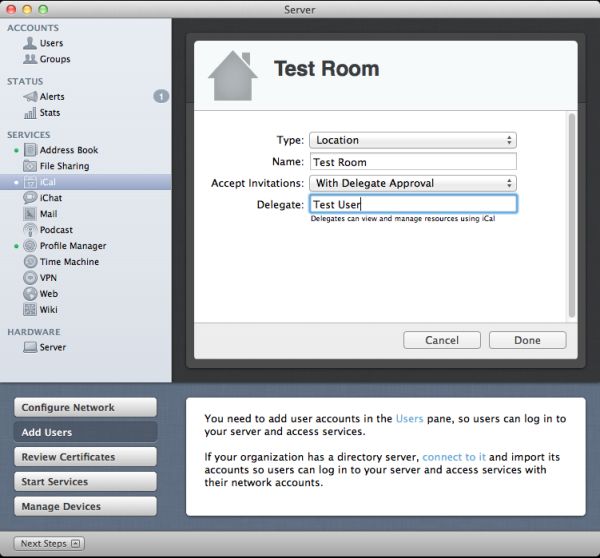



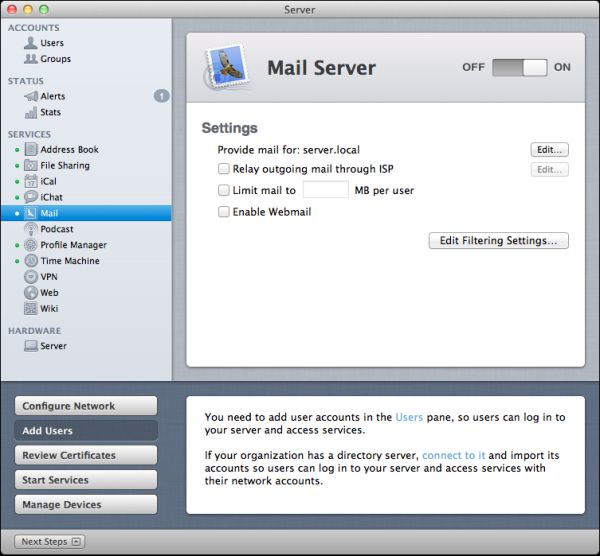
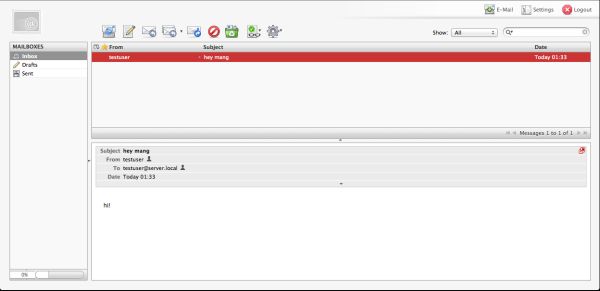









77 Comments
View All Comments
GrizzledYoungMan - Tuesday, August 2, 2011 - link
I probably should have toned down my sarcasm a bit, but my point is that while yes, Apple said they support SMB since 10.2, it just plain old doesn't work right.Google Thursby DAVE to see what I mean.
repoman27 - Tuesday, August 2, 2011 - link
I'm familiar with DAVE, and you're right that obviously much is to be desired with Apple's SMB implementation if there is still an aftermarket product that costs more than the OS itself just to fix this particular issue.I kinda feel like more of the problem has to do with Mac OS X's lack of native support for NTFS though, rather than SMB actually malfunctioning.
I chuckle that while you're thinking about "all the time that has been wasted trying to get OS X desktop clients to do things that have worked out in the real world for years now," I'm thinking about how much time I've wasted trying to get Windows Home versions to do things that Microsoft has artificially prevented them from doing so that they could sell customers an "upgrade". For instance, try setting up file sharing with user-level passwords and NTFS permissions on a network with Windows XP Home and Widows 7 Home Premium machines...
GrizzledYoungMan - Tuesday, August 2, 2011 - link
You'll get no argument from me that Windows' tiered pricing is a bummer. Up-selling is sleazy.But overall, I'd say that Windows actually represents a better value if you make the right upgrade choices (ie, XP straight to 7). For the price of a few of Apple's annual updates, you get something that lasts a few years longer, does a lot more, and puts you through the OS-version-transition rumpus less frequently.
While I can understand why the press loves the frequency of OS X revisions, I don't see it as a good thing for the user (and certainly not my own personal experience). Upgrading your OS is a pain, and to do it every year - lest you suffer the consequences of running a two year old, unsupported version of OS X - is a burden. And as I mentioned, the end result of this accelerated schedule is that the end users become the beta testers.
No wonder they're getting out of the desktop business. They can't handle anything much more complicated than a mobile phone OS.
repoman27 - Tuesday, August 2, 2011 - link
Since version 10.3, Mac OS X has been on a major revision update schedule that is much closer to once every 2 years (Leopard actually came 2.5 years after Tiger). In the early days of Mac OS X there were some teething issues that resulted in a more rapid release cycle, but I also seem to recall Microsoft releasing Windows 98, 98SE, ME, and 2000 in rather quick succession.Mac users are also free to skip every other version. Not to mention that upgrade pricing for Mac OS is way cheaper than Windows when you realize that you're getting the full-feature client version with a far more liberal license scheme and no activation based copy protection for $30. How much would it cost to legitimately upgrade every machine that you own or control from Windows Vista Home Basic 32-bit OEM to Windows 7 Ultimate 64-bit?
Apple released updates for Tiger for more than 3 years after it was discontinued. I guess if they had a stubborn enough install base they would be forced to continue support for a 9 year-old version of their OS as well.
What does a client version of Windows itself do that Mac OS does not, aside from allowing playback of Blu-ray discs?
If you've ever bought a retail Windows machine, you probably know that out of the box, under normal usage, the thing will be all but unusable in less than 18 months time, forcing you to buy another cheap POS Windows machine, or to perform a clean install of your OS. I love sacrificing 16% of a new system's performance to anti-virus software right off the bat, too.
RubberJ - Tuesday, August 2, 2011 - link
My system has been running Win7 since RTM and hasn't slowed.And does Antivirus really take 16% of your system performance or are you just talking out your arse?
http://www.tomshardware.com/reviews/anti-virus-vir...
Just as i thought...mac fanboy alert...
repoman27 - Wednesday, August 3, 2011 - link
Yeah, as soon as I posted that last comment I realized I had crossed the line into religious war territory.My point about crappy system performance and having to reinstall the OS was regarding the way retail PC's come preconfigured, and what the typical end-user then subjects them to, not your particular case. My personal Windows systems (I do actually use Windows on the daily) tend to work fine for years, but then again I also spend a lot of time building performance tuned system images. I also don't personally run antivirus software anymore, because I'm not a sucker.
As for that, I tend to refer more to the testing done by AV comparatives, and my own personal testing, but I certainly wasn't talking out my arse. 16% may indeed be hyperbole when talking about a new Sandy Bridge based system running Windows 7, but not at all on legacy equipment running XP or when running in a virtualized environment.
Anywho, my initial intent was merely to clarify various exaggerations or inaccuracies in this thread, but I guess I did end up painting myself as the fanboy with that previous rant.
Wizzdo - Wednesday, August 3, 2011 - link
As a power user, developer, and servicer for Windows and OS X I can tell you quite simply that, relative to OS X, Windows is an expensive frustrating bag of hurt for a great many typical users. OS X comes with a fantastic suite of software tailored very well to work with the OS and the OS is in turn tuned very well to work with the Hardware. Updates (even Major ones) are painless and offer excellent value for the investment. They are generally highly looked forward to by most OS X users.Anyone who claims Windows and a generic PC will likely serve the average user better simply does not have a clue. There really is little comparison now and OS X Lion just pushes the experience that much further ahead.
For much of my day I am forced to use Windows to develop SQL Server infrastructures. SQL Server is IMHO the best piece of software Microsoft has ever managed to make. However, my blood pressure drops considerably when I get to boot back into OS X where I can get some creative work done in a responsive pleasing modern environment that does not feel like a thinly veiled version of DOS.
Apple gets it right and that is why they are the revered technology leader in the industry right now.
Timemachine alone is worth the price of admission for anyone who values there work and wants effortless trustworthy backup and retrieval of it. Watch MS scramble to get this into their next OS just like so many other features. Apple didn't invent them all but knows how to make them work the way they should.
GrizzledYoungMan - Wednesday, August 3, 2011 - link
I would just like to point out that Wizzdo lives in a universe in which Windows 7 is a thinly veiled version of DOS, and Timemachine is a novel, useful feature.Sigh. OS X users.
ex2bot - Friday, August 5, 2011 - link
Actually, Time Machine IS a useful feature. Is it "novel"? It is novel in the sense that it is drop-dead simple. You plug in an external drive and click the 'Yes' button. Then as long as it is attached it makes complete + sequential backups. I use it on my Macs. I also clone periodically. Well, I don't clone. My drives do.The backup review interface works well, too. It's basically a specialized Finder window. I admit the star field is . . . interesting.
GrizzledYoungMan, has Time Machine not been useful for you? What happened when you used it? It's worked for me on multiple machines. Backing up is useful because hard drives fail eventually. Even hard drives attached to Windows PCs.
And Windows 7 *is* a thinly veiled version of DOS. See, Windows just a shell that sits on DOS. . . Nahhh! I'm just kidding ya. I know it's son of NT (or grandson maybe).
Ex2bot
Positronic Mac Fanbot ("Cannot harm humans" is just a guideline, I believe.)
justinf79 - Friday, August 5, 2011 - link
Way to show your ignorance there buddy...Windows, the security/virus nightmare where you're bombarded by OS security patches daily gets old fast. And quite frankly OS X is more powerful AND simpler. Windows has always been garbage.